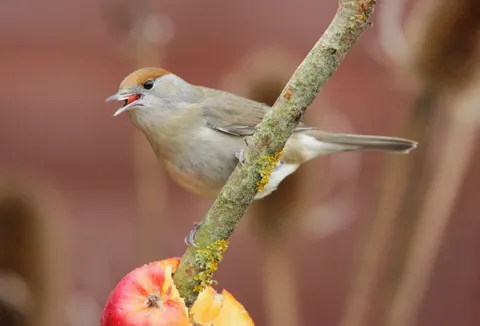How to spot a blackcap
Blackcaps are quite stocky birds, about the size of house sparrows. They are mainly light grey-brown in colour with the male having a neat black cap on its head, while the female’s cap is chestnut-brown.
In summer, recently fledged young also have a chestnut-brown cap, with young males gaining their black cap by late autumn.
Their liking of warmer conditions takes blackcaps mainly to the south and west of Britain and to Ireland during winter.
They are most often seen in suburban and urban gardens, where temperatures are that bit warmer than in rural areas and where food supplement availability is also greater.
Why are blackcap's aggressive?
Squabbles around bird feeders are par for the course as hungry visitors jockey for position, but one species, the blackcap, has a growing reputation for taking things to a different level.
Latest reports collected through the BTO Garden Blackcap Survey show that other birds can feel the blackcap's ire at feeders. Even robins, which are renowned for their feistiness, sometimes come off second best.
One possible reason for the blackcap's aggressive behaviour is that garden bird foods are incredibly important to the survival of the species.
Individuals that spend the winter with us are not the ones that nested here earlier in spring and summer, which departed south for the Mediterranean (Iberia and North Africa) in autumn. Instead, they are birds that bred in central Europe.
Normally, these central European blackcaps would also spend winter around the western Mediterranean, but a growing ‘splinter group’ now follows an alternative route, northwest to Britain and Ireland.
A few decades ago such wanderers would almost certainly have died as cold conditions and a lack of food took their toll. Now, however, our warming winter climate, coupled with copious amounts of food provided in gardens, means that this new migration route is strengthening.
Gaining the upper hand
Enduring a colder winter in Britain and Ireland than they would have experienced in the Mediterranean gives our wintering blackcaps an advantage.
The journey back to their breeding grounds in central Europe is shorter, meaning that our birds can return earlier and have the opportunity to claim the best breeding territories.
In central Europe, research shows that those blackcaps that winter with us fledge more youngsters than those wintering further south. As a result, there are more and more fledglings that are ‘programmed’ to migrate northwest to us in the autumn.
This change is borne out in the number of blackcaps that we now see at our garden feeding stations during winter, which has increased by 400 per cent between the 1970s and the current decade.

A female blackcap about to tuck into an apple. © Nick Stacey
Garden Blackcap Survey
Despite the far-reaching influences that our garden bird feeders appear to have on blackcaps, we have surprisingly little data about what these birds are eating in gardens and how they interact with other birds.
This January, you can shed light on this issue.
If you see a blackcap in your garden, please take part in the BTO Garden Blackcap Survey. It’s simple and will provide the BTO with really valuable information.
The British Trust of Ornithology (BTO) works in partnership with over 40,000 volunteer birdwatchers to chart the fortunes of UK birds.
Among the surveys that we coordinate is our popular Garden BirdWatch, the largest year-round survey of garden birds in the world.
Each month we highlight a bird for you to look out for in your garden.
For more information about Garden BirdWatch or to speak to the Garden Ecology Team please email gbw@bto.org
